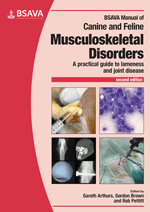
Full text loading...

This chapter discusses a range of congenital/developmental and acquired causes of shoulder lameness. Includes Quick Reference Guide to Imaging Techniques by Thomas W. Maddox. Operative Techniques: Craniomedial approach to the shoulder; Craniolateral approach to the shoulder; Caudolateral approach to the shoulder; Caudolateral arthrotomy for osteochondritis dissecans of the humeral head; Arthroscopy of the shoulder joint; Lateral shoulder stabilization; Medial shoulder stabilization – imbrication of the subscapularis muscle; Medial shoulder stabilization – placement of a medial collateral prosthesis; Tenotomy or tenodesis of the biceps brachii tendon of origin.
The shoulder, Page 1 of 1
< Previous page | Next page > /docserver/preview/fulltext/10.22233/9781910443286/9781910443286.18-1.gif

Full text loading...











































